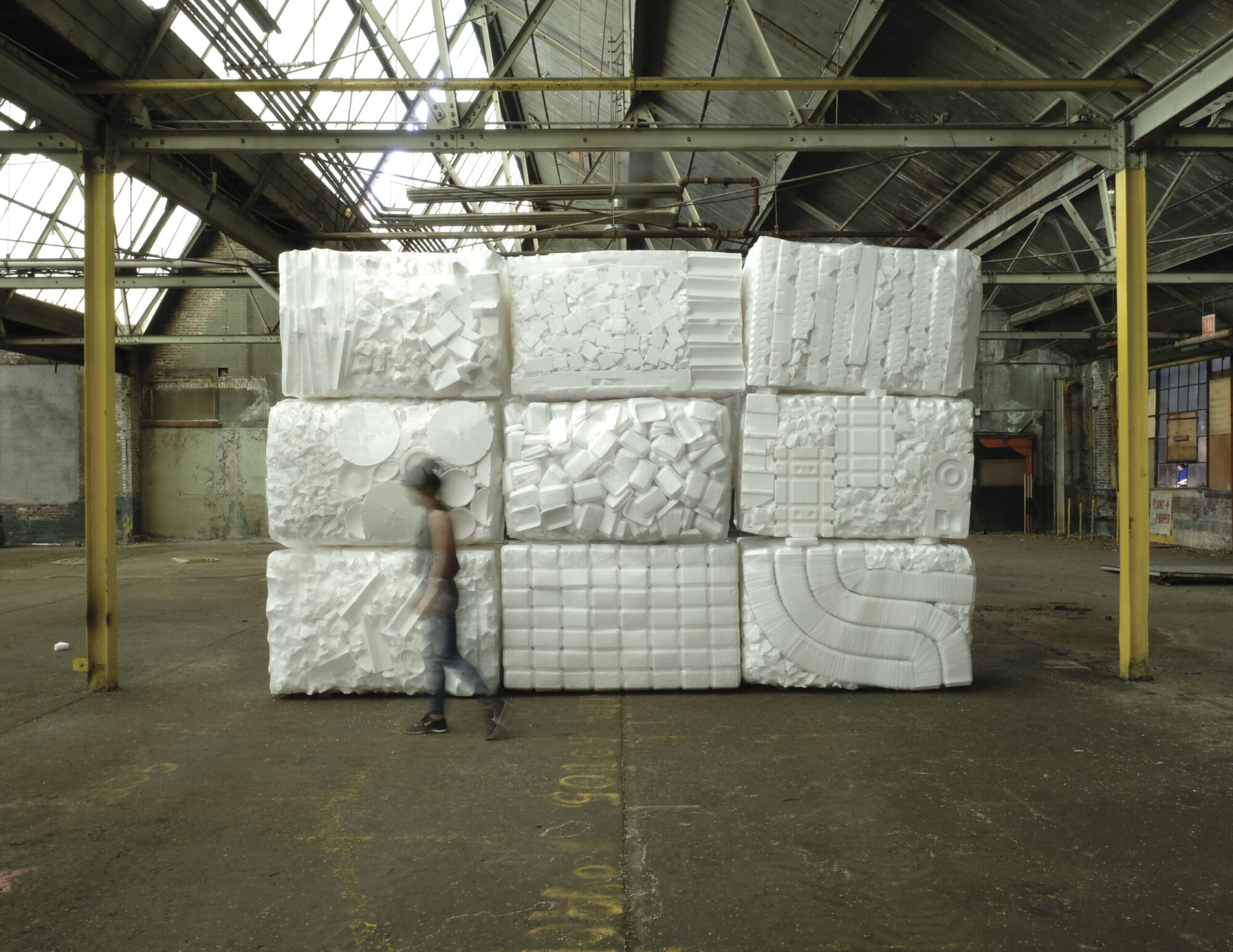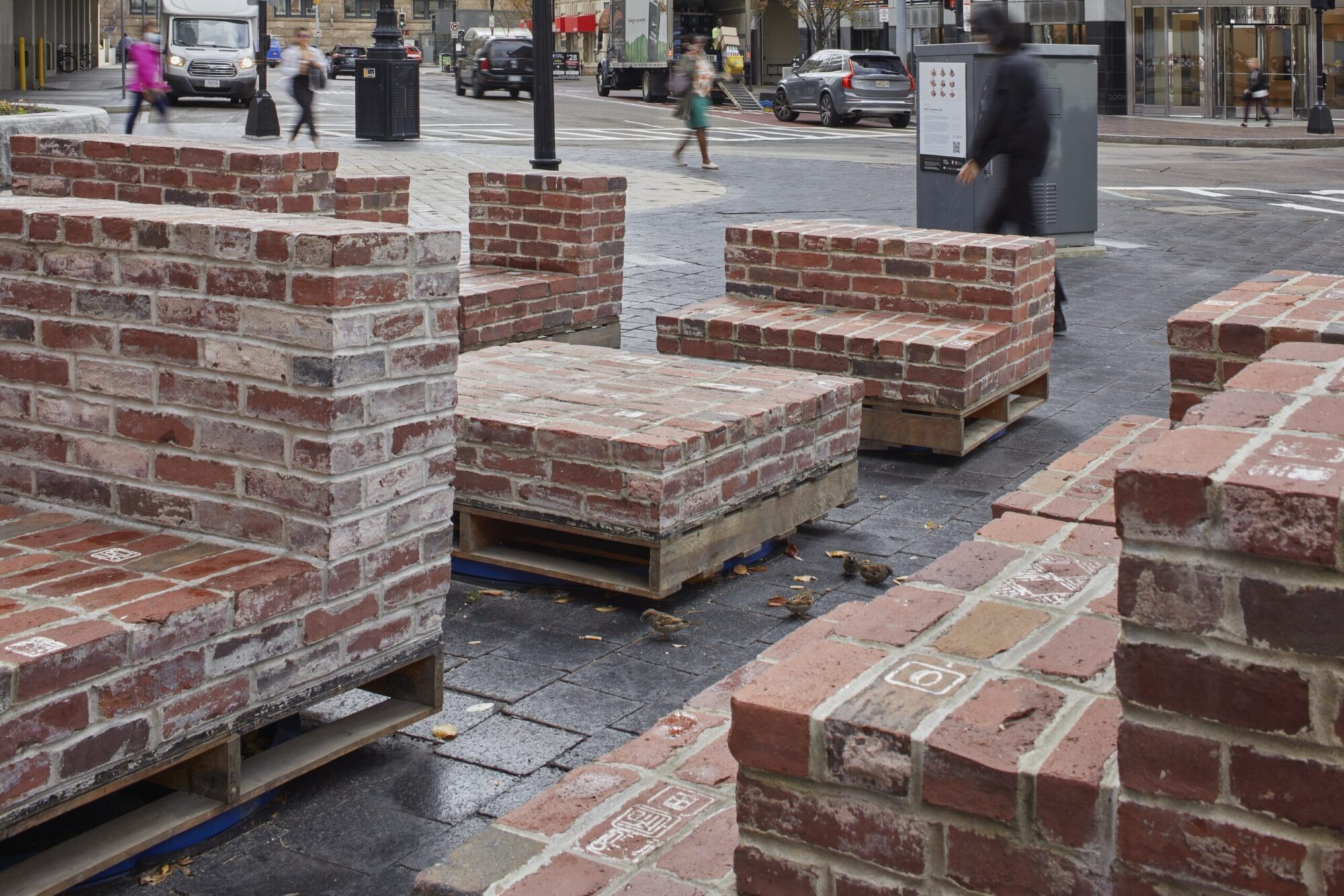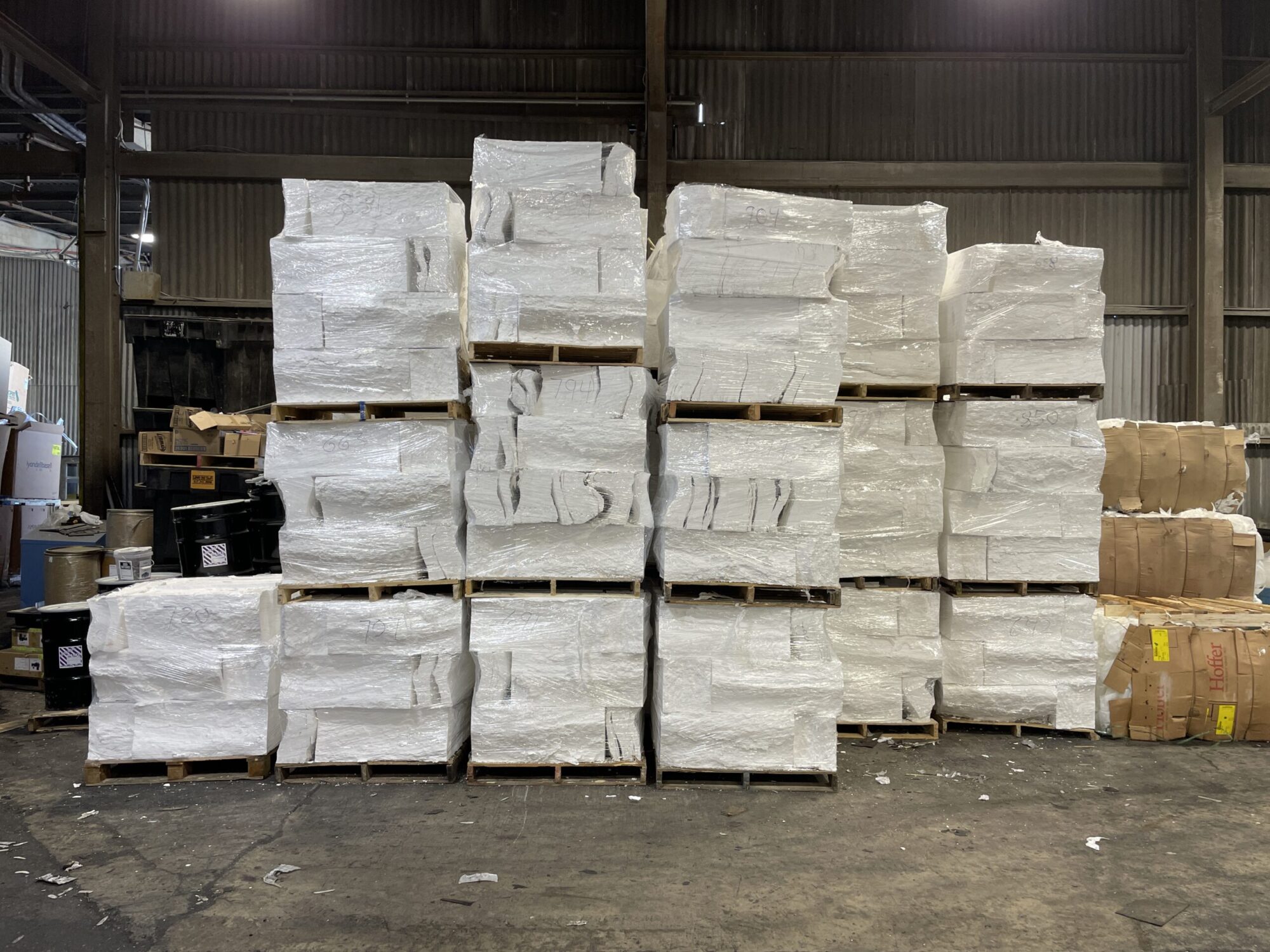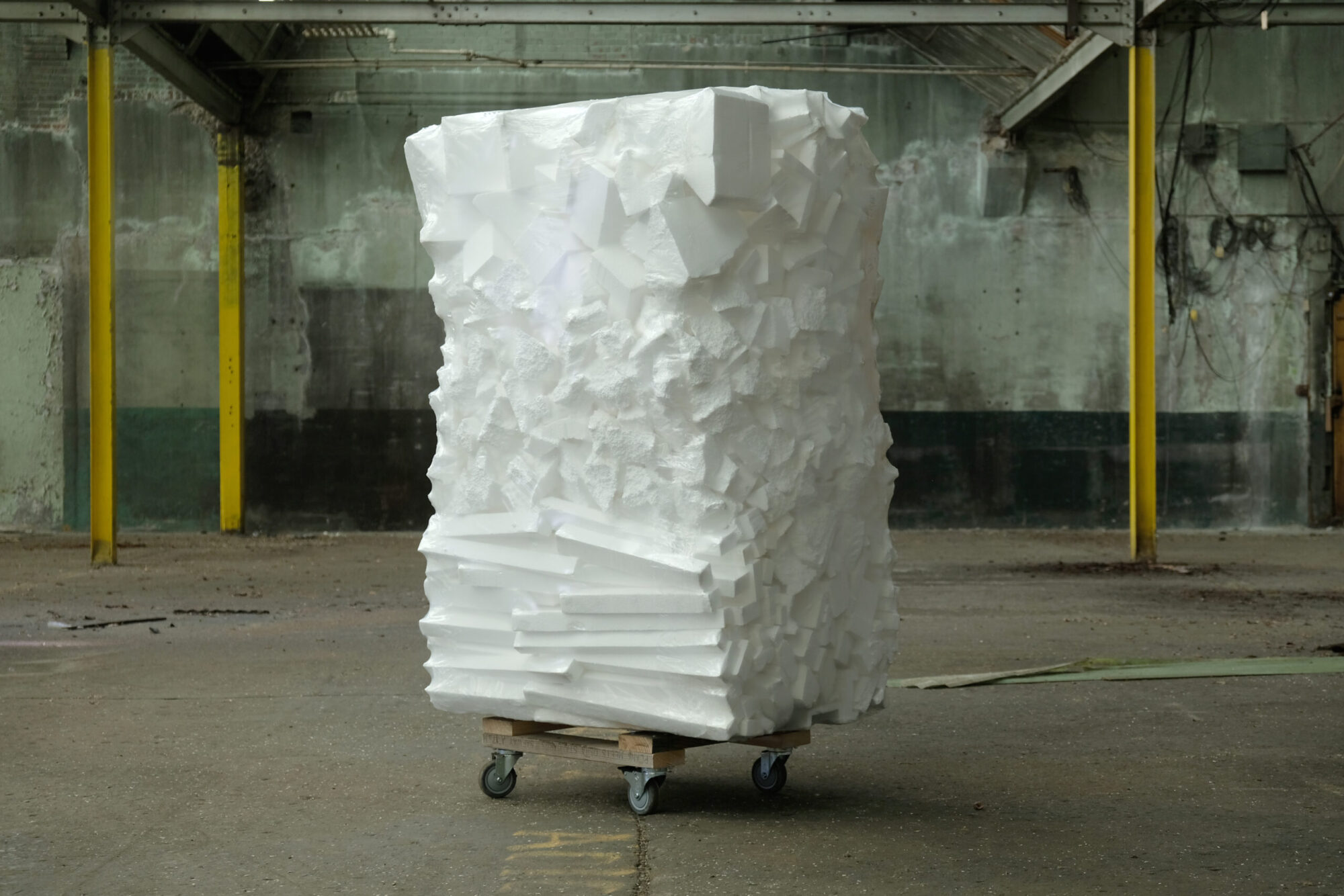
A. Ang Li, Balancing Acts, 2019, bales of scrap expanded polystyrene [photo: Billy Dufala; courtesy of the artist and RAIR, Philadelphia]
Stubborn Materialism: Stoppages, Blocks, and Piles
Share:
Art in urban public space contends with human patterns of attention and distraction, just as monuments, buildings, and advertisements do. Fixtures of public visibility, regardless of authorship, accrete meaning in their materiality, which is captured by collective spatial memory and other media of reference.
Since 2015, more than 100 spray painted, tarped, and ultimately removed Confederate monuments have provided a public lesson on the inherent understandings a monument relies upon for its cultural meaning. Historic preservation, as a discipline, establishes material methods that operate alongside methods of historical storytelling but did not help in providing guidelines for removal. In a vernacular sense, mythic meaning in public space persists beyond logic and beyond any official narrative. This evasiveness and disobedience of meaning is the legendary dimension of urban space. The elimination or guerrilla modification of something, spectacular or not, sends a jolt of new meaning into that collective mythos. The broader lesson demonstrates that monumentality is a contingent product of power—and that widespread collective morality plus spray paint can shift power.1
Activist Rebecca Solnit, describing her participation in a successful effort to block the construction of the massive nuclear waste repository planned for Yucca Mountain, in Nevada, observed that years of collective persistence against this federal initiative produced, in the end, nothing. Is this a special nothing? A victorious nothing? Does it represent something—such as resistance or salvation, for example, or is it precisely the figure of forgetting?2
B. Ang Li, Place of Assembly, 2022, reconstituted blocks of salvaged bricks [photo: Jane Messinger; courtesy of the artist]
An 1892 strike, coordinated by granite paving stone producers in Vinalhaven, ME, alongside pavers and dock workers along the East Coast, from Boston to Philadelphia, halted production of smooth roads in the bustling commercial cities of the Northeastern United States. Landscape historian Jane Hutton3 suggests that this stoppage, and the subsequent unavailability and immobility of material, led workers to understand material flows as re-organizable, not just stoppable. One immediate result was the formation of cooperatively owned businesses, and the development of interstate and inter-profession union relationships. The resulting piles of unused blocks along the supply chain became monuments to this otherwise invisible material interrelationship.
Austrian art historian Aloïs Riegl suggested in a 1903 essay4 that the romantic attitude toward aging architectural relics has a limit: When a structure crumbles to the point that “nothing is left but a shapeless pile of rubble, the monument becomes formless—reduced to illegibility, nothingness and death.”
Bricks, pavers, blocks, and other material units are packed with symbolism: power, industrial progress, labor, the abilities of a careful crafting hand, the abilities of a violent dissident hand. Philosopher Brian Massumi asserts, “A concept is a brick. It can be used to build the courthouse of reason. Or it can be thrown through the window …. What interests us are the circumstances.”
C. Ang Li, Balancing Acts, 2019, bales of scrap expanded polystyrene [photo: Billy Dufala; courtesy of the artist and RAIR, Philadelphia]
Operation National Sword was the name for China’s series of 2017 policy initiatives that strictly limited the import of low-quality waste plastics. As plastics accumulate in the US, about 85% is landfilled—much of that in Latin America—and 10% is incinerated. Italian collective Superstudio proposed, in a parodic 1972 essay “Salvages of Italian Historic Centers: Omens of Good Fortune for Your Cities,”5 to bury Rome with household trash and construction waste as a way of archaeologically preserving it against the ravages of the elements. They calculated that only about 20 years would be needed to bury the entire city center to an average depth of 60 meters, as Rome was producing 12,000 cubic meters of garbage daily in 1972. In the 1970s, the Italian discourse on architectural patrimony (which Superstudio wanted to re-bury) was inextricably linked to far-right political nationalism and anti-immigration.
In waste streams, baling is an operation of compaction, but it also unitizes unruly materials—making quantitative sense of formlessness—and prepares these materials for an afterlife or a movement to another place. Expanded polystyrene, itself an enabler of transit for delicate objects, is compressed into ingots 50 times more dense than its foam state. This operation optimizes for volume only in service of transporting discarded polystyrene itself, as the material is melted at its next destination.
Spoliage refers to the taking of old building components—spolia—and reusing them in the creation of new buildings and structures. As in “spoils of war,” latent dynamics of power solidify in monument form. In this vein, common details of classical architecture are said to be based upon trophies—animal or mineral—captured in battle, stacked, bundled, and festooned together. Salvage, by contrast, presumes that something has been discarded and then rescued. The loss, or illegibility, or natural expiry that must take place before something is salvaged enables forgetting and forgiving. There is no direct power leveraged over those who discard by those who glean and reuse. An afterglow of power lost rather than a triumphant power wielded—however imperfect, incomplete, or ghostly—brings the marginal act of salvage to the symbolic level of salvation.
D. Ang Li, Balancing Acts, 2019, bales of scrap expanded polystyrene [photo: Billy Dufala; courtesy of the artist and RAIR, Philadelphia]
These works by architectural artist Ang Li exist simply and rather stubbornly. Salvaged materials assembled, sorted, or composed gain legibility and even monumentality through blocky muteness and strong positioning in space. In relation to the sculptural work, the graphical diagram suggests a new order that could follow. The classical architectural “orders”—Doric, Ionic, and Corinthian—are called into question as privileged systems of articulation by the suggestion that all orders are actually composites, and as such they are salvaged.
Extended Image Captions:
A, C, D. Ang Li, Balancing Acts at RAIR (Recycled Artist In Residency), Philadelphia (2019). Photographs by Billy Dufala. These bales of scrap expanded polystyrene, collected in the RAIR industrial recycling facility, are used to show the multiple vectors of object movement and accretion native to the material and its properties. Often encasing more valuable commodities specifically during circulation, expanded polystyrene is a material manifestation of circulation.
B. Ang Li, Place of Assembly in Chinatown, Boston (2021). Photographs by Jane Messinger. These reconstituted blocks swivel to create an occupiable monument. They are reconstitutions of the street life of stoops, made from salvaged bricks from the 2020–2022 restoration of City Hall Plaza—one of the many urban renewal projects in Boston that leveled Black and immigrant neighborhoods and red-light districts for public plazas, monumental buildings, and highways.
Gabriel Cira is a licensed architect based in Massachusetts. He is an assistant professor in the history of art at MassArt, where he teaches the longstanding Architecture of Boston course, among other architecture and art history seminars. Cira’s professional practice and research work focus on historic preservation, vernacular/popular histories, ecological design, accessibility and preservation, and infrastructure history.
References
| ↑1 | Recent reactionary legislation has attempted to rein in and codify ownership of public monumentality to impede the groundswell of power against Confederate monuments; see Elaine Velie, “Florida pushes law to sue over removal of Confederate monuments,” Hyperallergic (April 18, 2023), online. |
|---|---|
| ↑2 | Rebecca Solnit, “The Angel of Alternate History,” in Hope in the Dark (2004), Nation Books, 70–72. |
| ↑3 | Jane Hutton, Reciprocal Landscapes: Stories of Material Movements (2019), Routledge, 66–103. |
| ↑4 | Aloïs Riegl, “The Modern Cult of Monuments: Its Character and Its Origin,” trans. Kurt W. Forster and Diane Ghirardo, in Oppositions, no. 25 (Fall 1982), 21–51. |
| ↑5 | Superstudio, “Salvages of Italian City Centers,” trans. Lucia Allais, in Log, no. 22, Spring/Summer 2011, 114–124. |


